Java Stream使用
Java Stream函数式编程接口最初是在Java 8中引入的,并且与lambda一起成为Java开发的里程碑式的功能特性,它极大的方便了开放人员处理集合类数据的效率。从笔者之前看过的调查文章显示,绝大部分的开发者使用的JDK版本是java 8,其中Java Stream和lambda功不可没。
Java Stream就是一个数据流经的管道,并且在管道中对数据进行操作,然后流入下一个管道。有学过linux 管道的同学应该会很容易就理解。在没有Java Stram之前,对于集合类的操作,更多的是通过for循环。大家从后文中就能看出Java Stream相对于for 循环更加简洁、易用、快捷。
管道的功能包括:Filter(过滤)、Map(映射)、sort(排序)等,集合数据通过Java Stream管道处理之后,转化为另一组集合或数据输出。
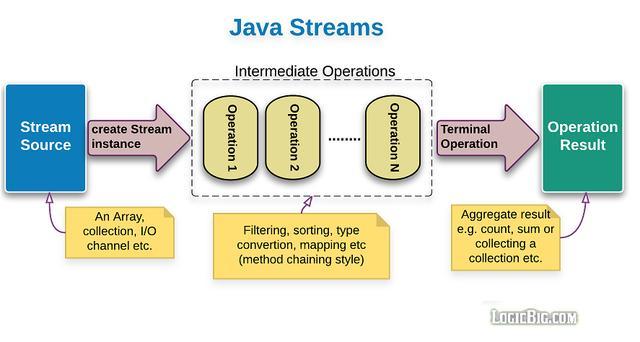
二、Stream API代替for循环
我们先来看一个例子:
List<String> nameStrs = Arrays.asList("Monkey", "Lion", "Giraffe","Lemur");
List<String> list = nameStrs.stream()
.filter(s -> s.startsWith("L"))
.map(String::toUpperCase)
.sorted()
.collect(toList());
System.out.println(list);
复制代码
- 首先,我们使用Stream()函数,将一个List转换为管道流
- 调用filter函数过滤数组元素,过滤方法使用lambda表达式,以L开头的元素返回true被保留,其他的List元素被过滤掉
- 然后调用Map函数对管道流中每个元素进行处理,字母全部转换为大写
- 然后调用sort函数,对管道流中数据进行排序
- 最后调用collect函数toList,将管道流转换为List返回
最终的输出结果是:[LEMUR, LION]。大家可以想一想,上面的这些对数组进行遍历的代码,如果你用for循环来写,需要写多少行代码?来,我们来继续学习Java Stream吧!
三、将数组转换为管道流
使用Stream.of()方法,将数组转换为管道流。
String[] array = {"Monkey", "Lion", "Giraffe", "Lemur"};
Stream<String> nameStrs2 = Stream.of(array);
Stream<String> nameStrs3 = Stream.of("Monkey", "Lion", "Giraffe", "Lemur");
复制代码
四、将集合类对象转换为管道流
通过调用集合类的stream()方法,将集合类对象转换为管道流。
List<String> list = Arrays.asList("Monkey", "Lion", "Giraffe", "Lemur");
Stream<String> streamFromList = list.stream();
Set<String> set = new HashSet<>(list);
Stream<String> streamFromSet = set.stream();
复制代码
五、将文本文件转换为管道流
通过Files.lines方法将文本文件转换为管道流,下图中的Paths.get()方法作用就是获取文件,是Java NIO的API!
也就是说:我们可以很方便的使用Java Stream加载文本文件,然后逐行的对文件内容进行处理。
Stream<String> lines = Files.lines(Paths.get("file.txt"));
复制代码
2.Stream的filter与谓语逻辑
一、基础代码准备
建立一个实体类,该实体类有五个属性。下面的代码使用了lombok的注解Data、AllArgsConstructor,这样我们就不用写get、set方法和全参构造函数了。lombok会帮助我们在编译期生成这些模式化的代码。
@Data
@AllArgsConstructor
public class Employee {
private Integer id;
private Integer age; //年龄
private String gender; //性别
private String firstName;
private String lastName;
}
复制代码
写一个测试类,这个测试类的内容也很简单,新建十个Employee 对象
public class StreamFilterPredicate {
public static void main(String[] args){
Employee e1 = new Employee(1,23,"M","Rick","Beethovan");
Employee e2 = new Employee(2,13,"F","Martina","Hengis");
Employee e3 = new Employee(3,43,"M","Ricky","Martin");
Employee e4 = new Employee(4,26,"M","Jon","Lowman");
Employee e5 = new Employee(5,19,"F","Cristine","Maria");
Employee e6 = new Employee(6,15,"M","David","Feezor");
Employee e7 = new Employee(7,68,"F","Melissa","Roy");
Employee e8 = new Employee(8,79,"M","Alex","Gussin");
Employee e9 = new Employee(9,15,"F","Neetu","Singh");
Employee e10 = new Employee(10,45,"M","Naveen","Jain");
List<Employee> employees = Arrays.asList(e1, e2, e3, e4, e5, e6, e7, e8, e9, e10);
List<Employee> filtered = employees.stream()
.filter(e -> e.getAge() > 70 && e.getGender().equals("M"))
.collect(Collectors.toList());
System.out.println(filtered);
}
}
复制代码
需要注意的是上面的filter传入了lambda表达式(之前的章节我们已经讲过了),表达过滤年龄大于70并且男性的Employee员工。输出如下:
[Employee(id=8, age=79, gender=M, firstName=Alex, lastName=Gussin)] 复制代码
二、什么是谓词逻辑?
下面要说我们的重点了,通过之前的章节的讲解,我们已经知道lambda表达式表达的是一个匿名接口函数的实现。那具体到Stream.filter()中,它表达的是什么呢?看下图:可以看出它表达的是一个Predicate接口,在英语中这个单词的意思是:谓词。

什么是谓词?(百度百科)

什么是谓词逻辑?
WHERE 和 AND 限定了主语employee是什么,那么WHERE和AND语句所代表的逻辑就是谓词逻辑
SELECT * FROM employee WHERE age > 70 AND gender = 'M' 复制代码
三、谓词逻辑的复用
通常情况下,filter函数中lambda表达式为一次性使用的谓词逻辑。如果我们的谓词逻辑需要被多处、多场景、多代码中使用,通常将它抽取出来单独定义到它所限定的主语实体中。 比如:将下面的谓词逻辑定义在Employee实体class中。
public static Predicate<Employee> ageGreaterThan70 = x -> x.getAge() >70;
public static Predicate<Employee> genderM = x -> x.getGender().equals("M");
复制代码
3.1.and语法(并集)
List<Employee> filtered = employees.stream()
.filter(Employee.ageGreaterThan70.and(Employee.genderM))
.collect(Collectors.toList());
复制代码
输出如下:
[Employee(id=8, age=79, gender=M, firstName=Alex, lastName=Gussin)] 复制代码
3.2.or语法(交集)
List<Employee> filtered = employees.stream()
.filter(Employee.ageGreaterThan70.or(Employee.genderM))
.collect(Collectors.toList());
复制代码
输出如下:实际上就是年龄大于70的和所有的男性(由于79的那位也是男性,所以就是所有的男性)
[Employee(id=1, age=23, gender=M, firstName=Rick, lastName=Beethovan), Employee(id=3, age=43, gender=M, firstName=Ricky, lastName=Martin), Employee(id=4, age=26, gender=M, firstName=Jon, lastName=Lowman), Employee(id=6, age=15, gender=M, firstName=David, lastName=Feezor), Employee(id=8, age=79, gender=M, firstName=Alex, lastName=Gussin), Employee(id=10, age=45, gender=M, firstName=Naveen, lastName=Jain)] 复制代码
3.3.negate语法(取反)
List<Employee> filtered = employees.stream()
.filter(Employee.ageGreaterThan70.or(Employee.genderM).negate())
.collect(Collectors.toList());
复制代码
输出如下:把上一小节代码的结果取反,实际上就是所有的女性
[Employee(id=2, age=13, gender=F, firstName=Martina, lastName=Hengis), Employee(id=5, age=19, gender=F, firstName=Cristine, lastName=Mar 复制代码
3.Stream管道流的map操作
一、回顾Stream管道流map的基础用法
最简单的需求:将集合中的每一个字符串,全部转换成大写!
List<String> alpha = Arrays.asList("Monkey", "Lion", "Giraffe", "Lemur");
//不使用Stream管道流
List<String> alphaUpper = new ArrayList<>();
for (String s : alpha) {
alphaUpper.add(s.toUpperCase());
}
System.out.println(alphaUpper); //[MONKEY, LION, GIRAFFE, LEMUR]
// 使用Stream管道流
List<String> collect = alpha.stream().map(String::toUpperCase).collect(Collectors.toList());
//上面使用了方法引用,和下面的lambda表达式语法效果是一样的
//List<String> collect = alpha.stream().map(s -> s.toUpperCase()).collect(Collectors.toList());
System.out.println(collect); //[MONKEY, LION, GIRAFFE, LEMUR]
复制代码
所以map函数的作用就是针对管道流中的每一个数据元素进行转换操作。
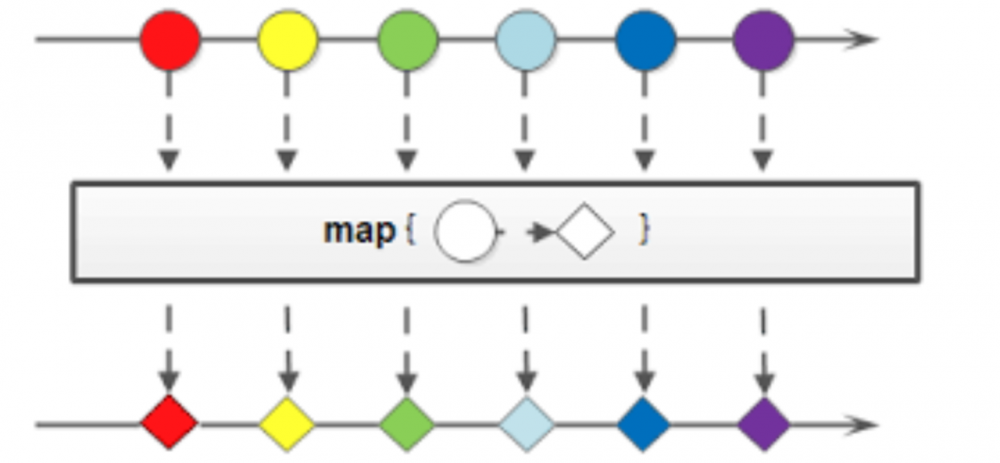
二、处理非字符串类型集合元素
map()函数不仅可以处理数据,还可以转换数据的类型。如下:
List<Integer> lengths = alpha.stream()
.map(String::length)
.collect(Collectors.toList());
System.out.println(lengths); //[6, 4, 7, 5]
Stream.of("Monkey", "Lion", "Giraffe", "Lemur")
.mapToInt(String::length)
.forEach(System.out::println);
复制代码
输出如下:
6 4 7 5 复制代码
除了mapToInt。还有maoToLong,mapToDouble等等用法
三、再复杂一点:处理对象数据格式转换
还是使用上一节中的Employee类,创建10个对象。需求如下:
- 将每一个Employee的年龄增加一岁
- 将性别中的“M”换成“male”,F换成Female。
public static void main(String[] args){
Employee e1 = new Employee(1,23,"M","Rick","Beethovan");
Employee e2 = new Employee(2,13,"F","Martina","Hengis");
Employee e3 = new Employee(3,43,"M","Ricky","Martin");
Employee e4 = new Employee(4,26,"M","Jon","Lowman");
Employee e5 = new Employee(5,19,"F","Cristine","Maria");
Employee e6 = new Employee(6,15,"M","David","Feezor");
Employee e7 = new Employee(7,68,"F","Melissa","Roy");
Employee e8 = new Employee(8,79,"M","Alex","Gussin");
Employee e9 = new Employee(9,15,"F","Neetu","Singh");
Employee e10 = new Employee(10,45,"M","Naveen","Jain");
List<Employee> employees = Arrays.asList(e1, e2, e3, e4, e5, e6, e7, e8, e9, e10);
/*List<Employee> maped = employees.stream()
.map(e -> {
e.setAge(e.getAge() + 1);
e.setGender(e.getGender().equals("M")?"male":"female");
return e;
}).collect(Collectors.toList());*/
List<Employee> maped = employees.stream()
.peek(e -> {
e.setAge(e.getAge() + 1);
e.setGender(e.getGender().equals("M")?"male":"female");
}).collect(Collectors.toList());
System.out.println(maped);
}
复制代码
由于map的参数e就是返回值,所以可以用peek函数。peek函数是一种特殊的map函数,当函数没有返回值或者参数就是返回值的时候可以使用peek函数。
四、flatMap
map可以对管道流中的数据进行转换操作,但是如果管道中还有管道该如何处理?即:如何处理二维数组及二维集合类。实现一个简单的需求:将“hello”,“world”两个字符串组成的集合,元素的每一个字母打印出来。如果不用Stream我们怎么写?写2层for循环,第一层遍历字符串,并且将字符串拆分成char数组,第二层for循环遍历char数组。
List<String> words = Arrays.asList("hello", "word");
words.stream()
.map(w -> Arrays.stream(w.split(""))) //[[h,e,l,l,o],[w,o,r,l,d]]
.forEach(System.out::println);
复制代码
输出打印结果:
java.util.stream.ReferencePipeline$Head@3551a94 java.util.stream.ReferencePipeline$Head@531be3c5 复制代码
- 用map方法是做不到的,这个需求用map方法无法实现。map只能针对一维数组进行操作,数组里面还有数组,管道里面还有管道,它是处理不了每一个元素的。
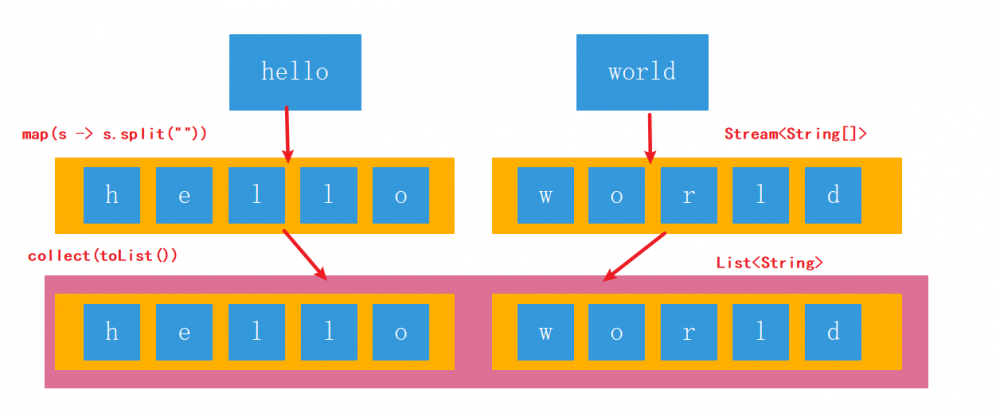
- flatMap可以理解为将若干个子管道中的数据全都,平面展开到父管道中进行处理。
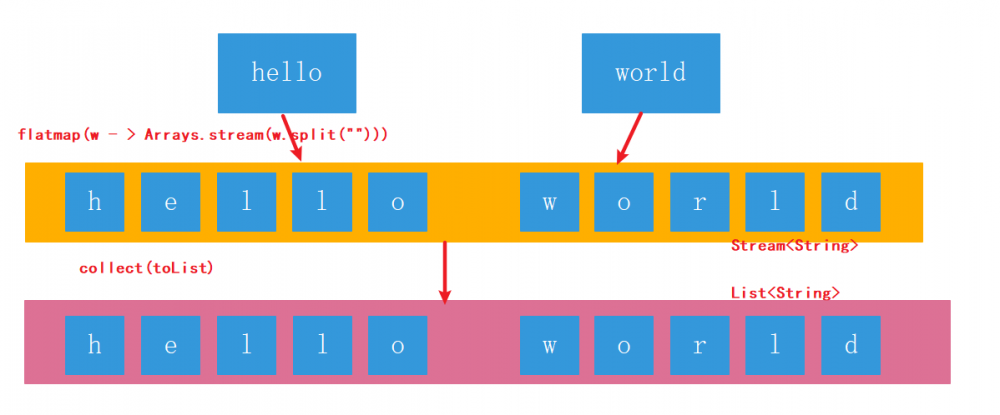
words.stream()
.flatMap(w -> Arrays.stream(w.split(""))) // [h,e,l,l,o,w,o,r,l,d]
.forEach(System.out::println);
复制代码
输出打印结果:
h e l l o w o r d 复制代码
4.Stream的状态与并行操作
一、回顾Stream管道流操作

通过前面章节的学习,我们应该明白了Stream管道流的基本操作。我们来回顾一下:
- 源操作:可以将数组、集合类、行文本文件转换成管道流Stream进行数据处理
- 中间操作:对Stream流中的数据进行处理,比如:过滤、数据转换等等
- 终端操作:作用就是将Stream管道流转换为其他的数据类型。这部分我们还没有讲,我们后面章节再介绍。
看下面的脑图,可以有更清晰的理解:
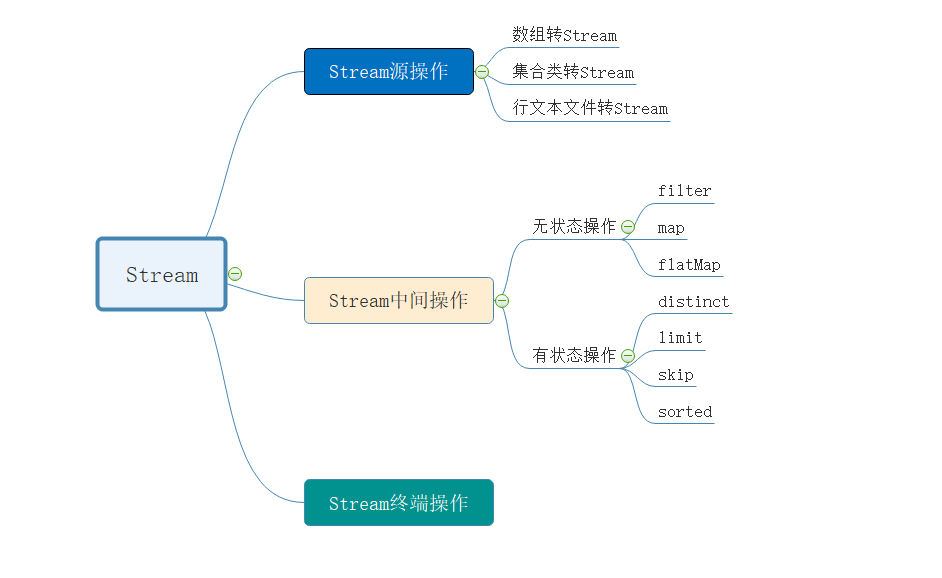
二、中间操作:有状态与无状态
其实在程序员编程中,经常会接触到“有状态”,“无状态”,绝大部分的人都比较蒙。而且在不同的场景下,“状态”这个词的含义似乎有所不同。但是“万变不离其宗”,理解“状态”这个词在编程领域的含义,笔者教给大家几个关键点:
- 状态通常代表公用数据,有状态就是有“公用数据”
- 因为有公用的数据,状态通常需要额外的存储。
- 状态通常被多人、多用户、多线程、多次操作,这就涉及到状态的管理及变更操作。
是不是更蒙了?举个例子,你就明白了
- web开发session就是一种状态,访问者的多次请求关联同一个session,这个session需要存储到内存或者redis。多次请求使用同一个公用的session,这个session就是状态数据。
- vue的vuex的store就是一种状态,首先它是多组件公用的,其次是不同的组件都可以修改它,最后它需要独立于组件单独存储。所以store就是一种状态。
回到我们的Stream管道流
- filter与map操作,不需要管道流的前面后面元素相关,所以不需要额外的记录元素之间的关系。输入一个元素,获得一个结果。
- sorted是排序操作、distinct是去重操作。像这种操作都是和别的元素相关的操作,我自己无法完成整体操作。就像班级点名就是无状态的,喊到你你就答到就可以了。如果是班级同学按大小个排序,那就不是你自己的事了,你得和周围的同学比一下身高并记住,你记住的这个身高比较结果就是一种“状态”。所以这种操作就是有状态操作。
三、Limit与Skip管道数据截取
List<String> limitN = Stream.of("Monkey", "Lion", "Giraffe", "Lemur")
.limit(2)
.collect(Collectors.toList());
List<String> skipN = Stream.of("Monkey", "Lion", "Giraffe", "Lemur")
.skip(2)
.collect(Collectors.toList());
复制代码
- limt方法传入一个整数n,用于截取管道中的前n个元素。经过管道处理之后的数据是:[Monkey, Lion]。
- skip方法与limit方法的使用相反,用于跳过前n个元素,截取从n到末尾的元素。经过管道处理之后的数据是: [Giraffe, Lemur]
四、Distinct元素去重
我们还可以使用distinct方法对管道中的元素去重,涉及到去重就一定涉及到元素之间的比较,distinct方法时调用Object的equals方法进行对象的比较的,如果你有自己的比较规则,可以重写equals方法。
List<String> uniqueAnimals = Stream.of("Monkey", "Lion", "Giraffe", "Lemur", "Lion")
.distinct()
.collect(Collectors.toList());
复制代码
上面代码去重之后的结果是: ["Monkey", "Lion", "Giraffe", "Lemur"]
五、Sorted排序
默认的情况下,sorted是按照字母的自然顺序进行排序。如下代码的排序结果是:[Giraffe, Lemur, Lion, Monkey],字数按顺序G在L前面,L在M前面。第一位无法区分顺序,就比较第二位字母。
List<String> alphabeticOrder = Stream.of("Monkey", "Lion", "Giraffe", "Lemur")
.sorted()
.collect(Collectors.toList());
复制代码
排序我们后面还会给大家详细的讲一讲,所以这里暂时只做一个了解。
六、串行、并行与顺序
通常情况下,有状态和无状态操作不需要我们去关心。除非?:你使用了并行操作。
还是用班级按身高排队为例:班级有一个人负责排序,这个排序结果最后就会是正确的。那如果有2个、3个人负责按大小个排队呢?最后可能就乱套了。一个人只能保证自己排序的人的顺序,他无法保证其他人的排队顺序。
- 串行的好处是可以保证顺序,但是通常情况下处理速度慢一些
- 并行的好处是对于元素的处理速度快一些(通常情况下),但是顺序无法保证。这 可能会导致 进行一些 有状态操作 的时候,最后得到的不是你想要的结果。
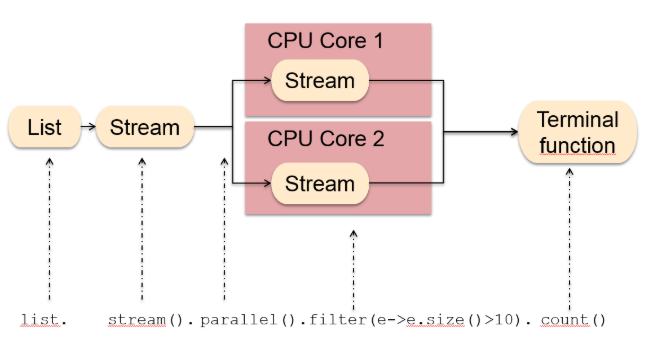
Stream.of("Monkey", "Lion", "Giraffe", "Lemur", "Lion")
.parallel()
.forEach(System.out::println);
复制代码
- parallel()函数表示对管道中的元素进行并行处理,而不是串行处理。但是这样就有可能导致管道流中后面的元素先处理,前面的元素后处理,也就是元素的顺序无法保证。
如果数据量比较小的情况下,不太能观察到,数据量大的话,就能观察到数据顺序是无法保证的。
Monkey Lion Lemur Giraffe Lion 复制代码
通常情况下,parallel()能够很好的利用CPU的多核处理器,达到更好的执行效率和性能,建议使用。但是有些特殊的情况下,parallel并不适合:深入了解请看这篇文章: blog.oio.de/2016/01/22/… 该文章中几个观点,说明并行操作的适用场景:
- 数据源易拆分:从处理性能的角度,parallel()更适合处理ArrayList,而不是LinkedList。因为ArrayList从数据结构上讲是基于数组的,可以根据索引很容易的拆分为多个。
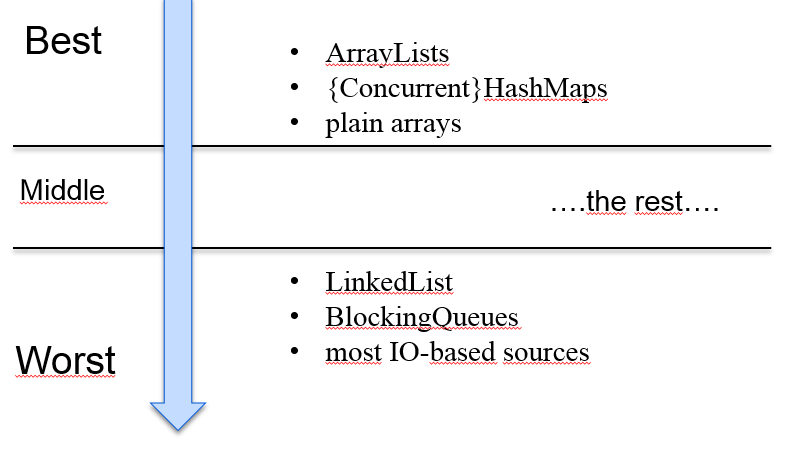
- 适用于无状态操作:每个元素的计算都不得依赖或影响任何其他元素的计算,的运算场景。
- 基础数据源无变化:从文本文件里面边读边处理的场景,不适合parallel()并行处理。parallel()一开始就容量固定的集合,这样能够平均的拆分、同步处理。
5.像使用SQL一样排序集合
在开始之前,我先卖个关子提一个问题:我们现在有一个Employee员工类。
@Data
@AllArgsConstructor
public class Employee {
private Integer id;
private Integer age; //年龄
private String gender; //性别
private String firstName;
private String lastName;
}
复制代码
你知道怎么对一个Employee对象组成的List集合, 先按照性别字段倒序排序,再按照年龄的倒序 进行排序么?如果您不知道4行代码以内的解决方案(其实是1行代码就可以实现,但笔者格式化为4行),我觉得您有必要一步步的看下去。
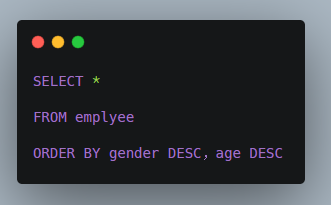
一、字符串List排序
cities是一个字符串数组。 注意london的首字母是小写的。
List<String> cities = Arrays.asList(
"Milan",
"london",
"San Francisco",
"Tokyo",
"New Delhi"
);
System.out.println(cities);
//[Milan, london, San Francisco, Tokyo, New Delhi]
cities.sort(String.CASE_INSENSITIVE_ORDER);
System.out.println(cities);
//[london, Milan, New Delhi, San Francisco, Tokyo]
cities.sort(Comparator.naturalOrder());
System.out.println(cities);
//[Milan, New Delhi, San Francisco, Tokyo, london]
复制代码
- 当使用sort方法,按照String.CASE_INSENSITIVE_ORDER(字母大小写不敏感)的规则排序,结果是:[london, Milan, New Delhi, San Francisco, Tokyo]
- 如果使用Comparator.naturalOrder()字母自然顺序排序,结果是:[Milan, New Delhi, San Francisco, Tokyo, london]
同样我们可以把排序器Comparator用在Stream管道流中。
cities.stream().sorted(Comparator.naturalOrder()).forEach(System.out::println); //Milan //New Delhi //San Francisco //Tokyo //london 复制代码
在java 7我们是使用Collections.sort()接受一个数组参数,对数组进行排序。 在java 8之后可以直接调用集合类的sort()方法进行排序 。sort()方法的参数是一个比较器Comparator接口的实现类,Comparator接口的我们下一节再给大家介绍一下。
二、整数类型List排序
List<Integer> numbers = Arrays.asList(6, 2, 1, 4, 9); System.out.println(numbers); //[6, 2, 1, 4, 9] numbers.sort(Comparator.naturalOrder()); //自然排序 System.out.println(numbers); //[1, 2, 4, 6, 9] numbers.sort(Comparator.reverseOrder()); //倒序排序 System.out.println(numbers); //[9, 6, 4, 2, 1] 复制代码
三、按对象字段对 List 排序
这个功能就比较有意思了,举个例子大家理解一下。
Employee e1 = new Employee(1,23,"M","Rick","Beethovan"); Employee e2 = new Employee(2,13,"F","Martina","Hengis"); Employee e3 = new Employee(3,43,"M","Ricky","Martin"); Employee e4 = new Employee(4,26,"M","Jon","Lowman"); Employee e5 = new Employee(5,19,"F","Cristine","Maria"); Employee e6 = new Employee(6,15,"M","David","Feezor"); Employee e7 = new Employee(7,68,"F","Melissa","Roy"); Employee e8 = new Employee(8,79,"M","Alex","Gussin"); Employee e9 = new Employee(9,15,"F","Neetu","Singh"); Employee e10 = new Employee(10,45,"M","Naveen","Jain"); List<Employee> employees = Arrays.asList(e1, e2, e3, e4, e5, e6, e7, e8, e9, e10); employees.sort(Comparator.comparing(Employee::getAge)); employees.forEach(System.out::println); 复制代码
- 首先,我们创建了10个Employee对象,然后将它们转换为List
- 然后重点的的代码:使用了函数应用Employee::getAge作为对象的排序字段,即使用员工的年龄作为排序字段
- 然后调用List的forEach方法将List排序结果打印出来,如下(当然我们重写了Employee的toString方法,不然打印结果没有意义):
Employee(id=2, age=13, gender=F, firstName=Martina, lastName=Hengis) Employee(id=6, age=15, gender=M, firstName=David, lastName=Feezor) Employee(id=9, age=15, gender=F, firstName=Neetu, lastName=Singh) Employee(id=5, age=19, gender=F, firstName=Cristine, lastName=Maria) Employee(id=1, age=23, gender=M, firstName=Rick, lastName=Beethovan) Employee(id=4, age=26, gender=M, firstName=Jon, lastName=Lowman) Employee(id=3, age=43, gender=M, firstName=Ricky, lastName=Martin) Employee(id=10, age=45, gender=M, firstName=Naveen, lastName=Jain) Employee(id=7, age=68, gender=F, firstName=Melissa, lastName=Roy) Employee(id=8, age=79, gender=M, firstName=Alex, lastName=Gussin) 复制代码
- 如果我们希望List按照年龄age的倒序排序,就使用reversed()方法。如:
employees.sort(Comparator.comparing(Employee::getAge).reversed()); 复制代码
四、Comparator链对 List 排序
下面这段代码先是按性别的倒序排序,再按照年龄的倒序排序。
employees.sort(
Comparator.comparing(Employee::getGender)
.thenComparing(Employee::getAge)
.reversed()
);
employees.forEach(System.out::println);
//都是正序 ,不加reversed
//都是倒序,最后面加一个reserved
//先是倒序(加reserved),然后正序
//先是正序(加reserved),然后倒序(加reserved)
复制代码
细心的朋友可能注意到:我们只用了一个reversed()倒序方法,这个和SQL的表述方式不太一样。这个问题不太好用语言描述,建议大家去看一下视频!
排序结果如下:
Employee(id=8, age=79, gender=M, firstName=Alex, lastName=Gussin) Employee(id=10, age=45, gender=M, firstName=Naveen, lastName=Jain) Employee(id=3, age=43, gender=M, firstName=Ricky, lastName=Martin) Employee(id=4, age=26, gender=M, firstName=Jon, lastName=Lowman) Employee(id=1, age=23, gender=M, firstName=Rick, lastName=Beethovan) Employee(id=6, age=15, gender=M, firstName=David, lastName=Feezor) Employee(id=7, age=68, gender=F, firstName=Melissa, lastName=Roy) Employee(id=5, age=19, gender=F, firstName=Cristine, lastName=Maria) Employee(id=9, age=15, gender=F, firstName=Neetu, lastName=Singh) Employee(id=2, age=13, gender=F, firstName=Martina, lastName=Hengis) 复制代码
6.函数式接口Comparator
一、函数式接口是什么?
所谓的函数式接口,实际上就是接口里面 只能有一个抽象方法的接口 。我们上一节用到的Comparator接口就是一个典型的函数式接口,它只有一个抽象方法compare。
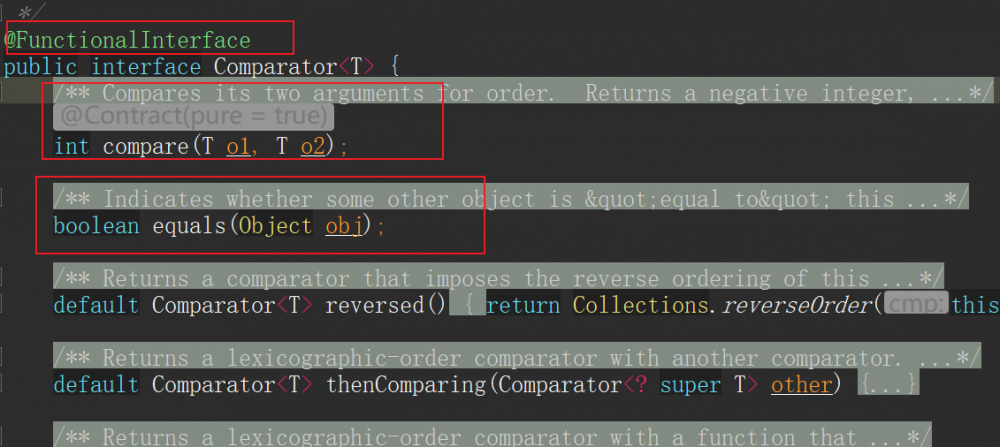
只有一个抽象方法?那上图中的equals方法不是也没有函数体么?不急,和我一起往下看!
二、函数式接口的特点
- 接口有且仅有一个抽象方法,如上图的抽象方法compare
- 允许定义静态非抽象方法
- 允许定义默认defalut非抽象方法(default方法也是java8才有的,见下文)
- 允许java.lang.Object中的public方法,如上图的方法equals。
- FunctionInterface注解不是必须的,如果一个接口符合"函数式接口"定义,那么加不加该注解都没有影响。加上该注解能够更好地让编译器进行检查。如果编写的不是函数式接口,但是加上了@FunctionInterface,那么编译器会报错
甚至可以说:函数式接口是专门为lambda表达式准备的, lambda表达式是只实现接口中唯一的抽象方法的匿名实现类 。
三、default关键字
顺便讲一下default关键字,在java8之前
- 接口是不能有方法的实现,所有方法全都是抽象方法
- 实现接口就必须实现接口里面的所有方法
这就导致一个问题: 当一个接口有很多的实现类的时候,修改这个接口就变成了一个非常麻烦的事,需要修改这个接口的所有实现类 。
这个问题困扰了java工程师许久,不过在java8中这个问题得到了解决,没错就是default方法
- default方法可以有自己的默认实现,即有方法体。
- 接口实现类可以不去实现default方法,并且可以使用default方法。
四、JDK中的函数式接口举例
java.lang.Runnable,
java.util.Comparator,
java.util.concurrent.Callable
java.util.function包下的接口,如Consumer、Predicate、Supplier等
五、自定义Comparator排序
我们自定义一个排序器,实现compare函数(函数式接口Comparator唯一的抽象方法)。返回0表示元素相等,-1表示前一个元素小于后一个元素,1表示前一个元素大于后一个元素。这个规则和java 8之前没什么区别。
下面代码用自定义接口实现类的的方式实现:按照年龄的倒序排序!
employees.sort(new Comparator<Employee>() {
@Override
public int compare(Employee em1, Employee em2) {
if(em1.getAge() == em2.getAge()){
return 0;
}
return em1.getAge() - em2.getAge() > 0 ? -1:1;
}
});
employees.forEach(System.out::println);
复制代码
最终的打印结果如下,按照年龄的自定义规则进行排序。
Employee(id=8, age=79, gender=M, firstName=Alex, lastName=Gussin) Employee(id=7, age=68, gender=F, firstName=Melissa, lastName=Roy) Employee(id=10, age=45, gender=M, firstName=Naveen, lastName=Jain) Employee(id=3, age=43, gender=M, firstName=Ricky, lastName=Martin) Employee(id=4, age=26, gender=M, firstName=Jon, lastName=Lowman) Employee(id=1, age=23, gender=M, firstName=Rick, lastName=Beethovan) Employee(id=5, age=19, gender=F, firstName=Cristine, lastName=Maria) Employee(id=9, age=15, gender=F, firstName=Neetu, lastName=Singh) Employee(id=6, age=15, gender=M, firstName=David, lastName=Feezor) Employee(id=2, age=13, gender=F, firstName=Martina, lastName=Hengis) 复制代码
这段代码如果以lambda表达式简写。箭头左侧是参数,右侧是函数体,参数类型和返回值根据上下文自动判断。如下:
employees.sort((em1,em2) -> {
if(em1.getAge() == em2.getAge()){
return 0;
}
return em1.getAge() - em2.getAge() > 0 ? -1:1;
});
employees.forEach(System.out::println);
复制代码
7.Stream查找与匹配元素
在我们对数组或者集合类进行操作的时候,经常会遇到这样的需求,比如:
- 是否包含某一个“匹配规则”的元素
- 是否所有的元素都符合某一个“匹配规则”
- 是否所有元素都不符合某一个“匹配规则”
- 查找第一个符合“匹配规则”的元素
- 查找任意一个符合“匹配规则”的元素
这些需求如果用for循环去写的话,还是比较麻烦的,需要使用到for循环和break!本节就介绍一个如何用Stream API来实现“查找与匹配”。
一、对比一下有多简单
employees是10个员工对象组成的List,在前面的章节中我们已经用过多次,这里不再列出代码。
如果我们不用Stream API实现,查找员工列表中是否包含年龄大于70的员工?代码如下:
boolean isExistAgeThan70 = false;
for(Employee employee:employees){
if(employee.getAge() > 70){
isExistAgeThan70 = true;
break;
}
}
复制代码
如果我们使用Stream API就是下面的一行代码,其中使用到了我们之前学过的"谓词逻辑"。
boolean isExistAgeThan70 = employees.stream().anyMatch(Employee.ageGreaterThan70); 复制代码
将谓词逻辑换成lambda表达式也可以,代码如下:
boolean isExistAgeThan72 = employees.stream().anyMatch(e -> e.getAge() > 72); 复制代码
所以,我们介绍了第一个匹配规则函数:anyMatch,判断Stream流中是否包含某一个“匹配规则”的元素。这个匹配规则可以是 lambda表达式 或者 谓词 。
二、其他匹配规则函数介绍
- 是否所有员工的年龄都大于10岁?allMatch匹配规则函数:判断是够Stream流中的所有元素都 符合 某一个"匹配规则"。
boolean isExistAgeThan10 = employees.stream().allMatch(e -> e.getAge() > 10); 复制代码
- 是否不存在小于18岁的员工?noneMatch匹配规则函数:判断是否Stream流中的所有元素都 不符合 某一个"匹配规则"。
boolean isExistAgeLess18 = employees.stream().noneMatch(e -> e.getAge() < 18); 复制代码
三、元素查找与Optional
从列表中按照顺序查找第一个年龄大于40的员工。
Optional<Employee> employeeOptional
= employees.stream().filter(e -> e.getAge() > 40).findFirst();
System.out.println(employeeOptional.get());
复制代码
打印结果
Employee(id=3, age=43, gender=M, firstName=Ricky, lastName=Martin) 复制代码
Optional类代表一个值存在或者不存在。在java8中引入,这样就不用返回null了。
- isPresent() 将在 Optional 包含值的时候返回 true , 否则返回 false 。
- ifPresent(Consumer block) 会在值存在的时候执行给定的代码块。我们在第3章 介绍了 Consumer 函数式接口;它让你传递一个接收 T 类型参数,并返回 void 的Lambda 表达式。
- T get() 会在值存在时返回值,否则?出一个 NoSuchElement 异常。
- T orElse(T other) 会在值存在时返回值,否则返回一个默认值。
关于Optinal的各种函数用法请观看视频! B站观看地址
- findFirst用于查找第一个符合“匹配规则”的元素,返回值为Optional
- findAny用于查找任意一个符合“匹配规则”的元素,返回值为Optional
8.Stream集合元素归约
Stream API为我们提供了 Stream.reduce 用来实现集合元素的归约。reduce函数有三个参数:
- Identity标识 :一个元素,它是归约操作的初始值,如果流为空,则为默认结果。
- Accumulator累加器 :具有两个参数的函数:归约运算的部分结果和流的下一个元素。
- Combiner合并器(可选) :当归约并行化时,或当累加器参数的类型与累加器实现的类型不匹配时,用于合并归约操作的部分结果的函数。
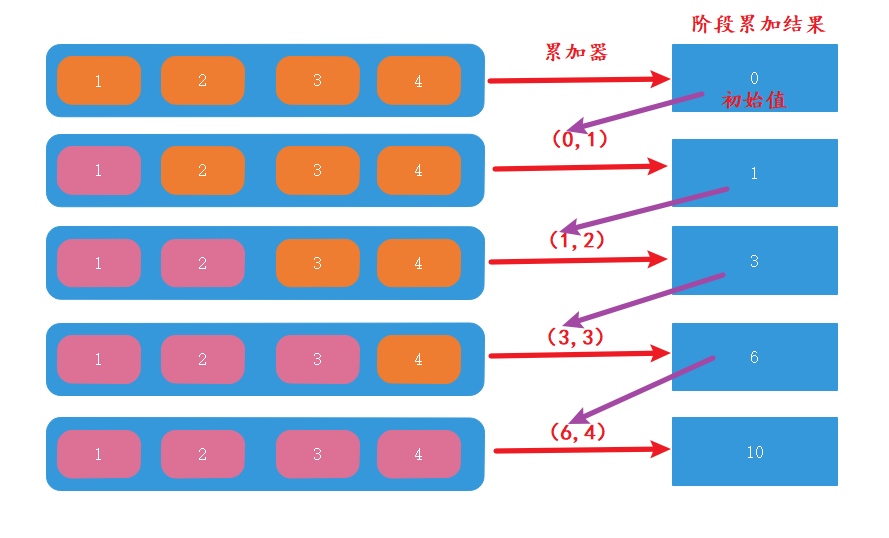
- 阶段累加结果作为累加器的第一个参数
- 集合遍历元素作为累加器的第二个参数
Integer类型归约
reduce初始值为0,累加器可以是lambda表达式,也可以是方法引用。
List<Integer> numbers = Arrays.asList(1, 2, 3, 4, 5, 6);
int result = numbers
.stream()
.reduce(0, (subtotal, element) -> subtotal + element);
System.out.println(result); //21
int result = numbers
.stream()
.reduce(0, Integer::sum);
System.out.println(result); //21
复制代码
String类型归约
不仅可以归约Integer类型,只要累加器参数类型能够匹配,可以对任何类型的集合进行归约计算。
List<String> letters = Arrays.asList("a", "b", "c", "d", "e");
String result = letters
.stream()
.reduce("", (partialString, element) -> partialString + element);
System.out.println(result); //abcde
String result = letters
.stream()
.reduce("", String::concat);
System.out.println(result); //ancde
复制代码
复杂对象归约
计算所有的员工的年龄总和。
Employee e1 = new Employee(1,23,"M","Rick","Beethovan"); Employee e2 = new Employee(2,13,"F","Martina","Hengis"); Employee e3 = new Employee(3,43,"M","Ricky","Martin"); Employee e4 = new Employee(4,26,"M","Jon","Lowman"); Employee e5 = new Employee(5,19,"F","Cristine","Maria"); Employee e6 = new Employee(6,15,"M","David","Feezor"); Employee e7 = new Employee(7,68,"F","Melissa","Roy"); Employee e8 = new Employee(8,79,"M","Alex","Gussin"); Employee e9 = new Employee(9,15,"F","Neetu","Singh"); Employee e10 = new Employee(10,45,"M","Naveen","Jain"); List<Employee> employees = Arrays.asList(e1, e2, e3, e4, e5, e6, e7, e8, e9, e10); Integer total = employees.stream().map(Employee::getAge).reduce(0,Integer::sum); System.out.println(total); //346 复制代码
- 先用map将Stream流中的元素由Employee类型处理为Integer类型(age)。
- 然后对Stream流中的Integer类型进行归约
Combiner合并器的使用
除了使用map函数实现类型转换后的集合归约,我们还可以用Combiner合并器来实现,这里第一次使用到了Combiner合并器。 因为Stream流中的元素是Employee,累加器的返回值是Integer,所以二者的类型不匹配。这种情况下可以使用Combiner合并器对累加器的结果进行二次归约,相当于做了类型转换。
Integer total3 = employees.stream()
.reduce(0,(totalAge,emp) -> totalAge + emp.getAge(),Integer::sum); //注意这里reduce方法有三个参数
System.out.println(total); //346
复制代码
计算结果和使用map进行数据类型转换的方式是一样的。
并行流数据归约(使用合并器)
对于大数据量的集合元素归约计算,更能体现出Stream并行流计算的威力。
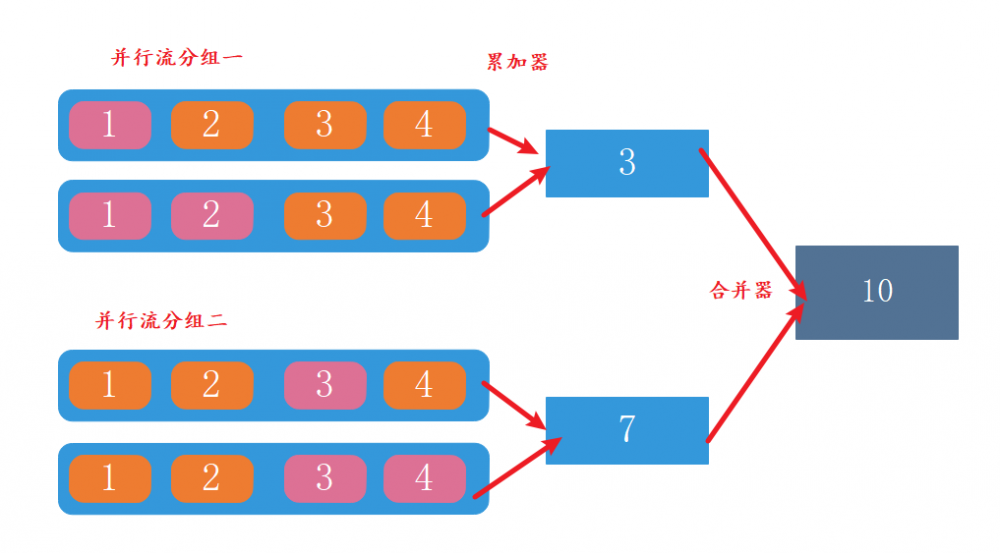
在进行并行流计算的时候,可能会将集合元素分成多个组计算。为了更快的将分组计算结果累加,可以使用合并器。
Integer total2 = employees
.parallelStream()
.map(Employee::getAge)
.reduce(0,Integer::sum,Integer::sum); //注意这里reduce方法有三个参数
System.out.println(total); //346
复制代码
9.StreamAPI终端操作
一、Java Stream管道数据处理操作
在本号之前写过的文章中,曾经给大家介绍过 Java Stream管道流是用于简化集合类元素处理的java API。在使用的过程中分为三个阶段。在开始本文之前,我觉得仍然需要给一些新朋友介绍一下这三个阶段,如图:

- 第一阶段(图中蓝色):将集合、数组、或行文本文件转换为java Stream管道流
- 第二阶段(图中虚线部分):管道流式数据处理操作,处理管道中的每一个元素。上一个管道中的输出元素作为下一个管道的输入元素。
- 第三阶段(图中绿色):管道流结果处理操作,也就是本文的将介绍的核心内容。
在开始学习之前,仍然有必要回顾一下我们之前给大家讲过的一个例子:
List<String> nameStrs = Arrays.asList("Monkey", "Lion", "Giraffe","Lemur");
List<String> list = nameStrs.stream()
.filter(s -> s.startsWith("L"))
.map(String::toUpperCase)
.sorted()
.collect(toList());
System.out.println(list);
复制代码
[LEMUR, LION]
如果你不使用java Stream管道流的话,想一想你需要多少行代码完成上面的功能呢?回到正题,这篇文章就是要给大家介绍第三阶段:对管道流处理结果都可以做哪些操作呢?下面开始吧!
二、ForEach和ForEachOrdered
如果我们只是希望将Stream管道流的处理结果打印出来,而不是进行类型转换,我们就可以使用forEach()方法或forEachOrdered()方法。
Stream.of("Monkey", "Lion", "Giraffe", "Lemur", "Lion")
.parallel()
.forEach(System.out::println);
Stream.of("Monkey", "Lion", "Giraffe", "Lemur", "Lion")
.parallel()
.forEachOrdered(System.out::println);
复制代码
- parallel()函数表示对管道中的元素进行并行处理,而不是串行处理,这样处理速度更快。但是这样就有可能导致管道流中后面的元素先处理,前面的元素后处理,也就是元素的顺序无法保证
- forEachOrdered从名字上看就可以理解,虽然在数据处理顺序上可能无法保障,但是forEachOrdered方法可以在元素输出的顺序上保证与元素进入管道流的顺序一致。也就是下面的样子(forEach方法则无法保证这个顺序):
Monkey Lion Giraffe Lemur Lion 复制代码
三、元素的收集collect
java Stream 最常见的用法就是:一将集合类转换成管道流,二对管道流数据处理,三将管道流处理结果在转换成集合类。那么collect()方法就为我们提供了这样的功能:将管道流处理结果在转换成集合类。
3.1.收集为Set
通过Collectors.toSet()方法收集Stream的处理结果,将所有元素收集到Set集合中。
Set<String> collectToSet = Stream.of( "Monkey", "Lion", "Giraffe", "Lemur", "Lion" ) .collect(Collectors.toSet()); //最终collectToSet 中的元素是:[Monkey, Lion, Giraffe, Lemur],注意Set会去重。 复制代码
3.2.收集到List
同样,可以将元素收集到 List 使用 toList() 收集器中。
List<String> collectToList = Stream.of( "Monkey", "Lion", "Giraffe", "Lemur", "Lion" ).collect(Collectors.toList()); // 最终collectToList中的元素是: [Monkey, Lion, Giraffe, Lemur, Lion] 复制代码
3.3.通用的收集方式
上面为大家介绍的元素收集方式,都是专用的。比如使用Collectors.toSet()收集为Set类型集合;使用Collectors.toList()收集为List类型集合。那么,有没有一种比较通用的数据元素收集方式,将数据收集为任意的Collection接口子类型。 所以,这里就像大家介绍一种通用的元素收集方式,你可以将数据元素收集到任意的Collection类型:即向所需Collection类型提供构造函数的方式。
LinkedList<String> collectToCollection = Stream.of( "Monkey", "Lion", "Giraffe", "Lemur", "Lion" ).collect(Collectors.toCollection(LinkedList::new)); //最终collectToCollection中的元素是: [Monkey, Lion, Giraffe, Lemur, Lion] 复制代码
注意:代码中使用了LinkedList::new,实际是调用LinkedList的构造函数,将元素收集到Linked List。当然你还可以使用诸如 LinkedHashSet::new 和 PriorityQueue::new 将数据元素收集为其他的集合类型,这样就比较通用了。
3.4.收集到Array
通过toArray(String[]::new)方法收集Stream的处理结果,将所有元素收集到字符串数组中。
String[] toArray = Stream.of( "Monkey", "Lion", "Giraffe", "Lemur", "Lion" ) .toArray(String[]::new); //最终toArray字符串数组中的元素是: [Monkey, Lion, Giraffe, Lemur, Lion] 复制代码
3.5.收集到Map
使用Collectors.toMap()方法将数据元素收集到Map里面,但是出现一个问题:那就是管道中的元素是作为key,还是作为value。我们用到了一个Function.identity()方法,该方法很简单就是返回一个“ t -> t ”(输入就是输出的lambda表达式)。另外使用管道流处理函数 distinct() 来确保Map键值的唯一性。
Map<String, Integer> toMap = Stream.of(
"Monkey", "Lion", "Giraffe", "Lemur", "Lion"
)
.distinct()
.collect(Collectors.toMap(
Function.identity(), //元素输入就是输出,作为key
s -> (int) s.chars().distinct().count()// 输入元素的不同的字母个数,作为value
));
// 最终toMap的结果是: {Monkey=6, Lion=4, Lemur=5, Giraffe=6}
复制代码
3.6.分组收集groupingBy
Collectors.groupingBy用来实现元素的分组收集,下面的代码演示如何根据首字母将不同的数据元素收集到不同的List,并封装为Map。
Map<Character, List<String>> groupingByList = Stream.of(
"Monkey", "Lion", "Giraffe", "Lemur", "Lion"
)
.collect(Collectors.groupingBy(
s -> s.charAt(0) , //根据元素首字母分组,相同的在一组
// counting() // 加上这一行代码可以实现分组统计
));
// 最终groupingByList内的元素: {G=[Giraffe], L=[Lion, Lemur, Lion], M=[Monkey]}
//如果加上counting() ,结果是: {G=1, L=3, M=1}
复制代码
这是该过程的说明:groupingBy第一个参数作为分组条件,第二个参数是子收集器。
四、其他常用方法
boolean containsTwo = IntStream.of(1, 2, 3).anyMatch(i -> i == 2);
// 判断管道中是否包含2,结果是: true
long nrOfAnimals = Stream.of(
"Monkey", "Lion", "Giraffe", "Lemur"
).count();
// 管道中元素数据总计结果nrOfAnimals: 4
int sum = IntStream.of(1, 2, 3).sum();
// 管道中元素数据累加结果sum: 6
OptionalDouble average = IntStream.of(1, 2, 3).average();
//管道中元素数据平均值average: OptionalDouble[2.0]
int max = IntStream.of(1, 2, 3).max().orElse(0);
//管道中元素数据最大值max: 3
IntSummaryStatistics statistics = IntStream.of(1, 2, 3).summaryStatistics();
// 全面的统计结果statistics: IntSummaryStatistics{count=3, sum=6, min=1, average=2.000000, max=3}
复制代码
10.java8如何排序Map
在这篇文章中,您将学习 如何使用Java对Map进行排序 。前几日有位朋友面试遇到了这个问题,看似很简单的问题,但是如果不仔细研究一下也是很容易让人懵圈的面试题。所以我决定写这样一篇文章。在Java中,有多种方法可以对Map进行排序,但是我们将重点介绍Java 8 Stream,这是实现目标的一种非常优雅的方法。
一、什么是Java 8 Stream
使用Java 8 Streams,我们可以按键和按值对映射进行排序。下面是它的工作原理:
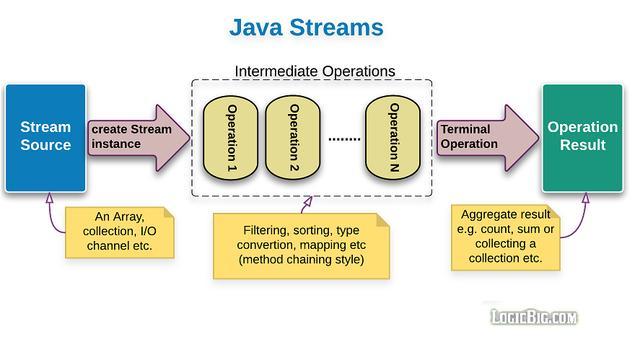
sorted() LinkedHashMap
sorted() 方法以a Comparator 作为参数,从而可以按任何类型的值对Map进行排序。如果对Comparator不熟悉,可以看本号前几天的文章,有一篇文章专门介绍了使用Comparator对List进行排序。
二、学习一下HashMap的merge()函数
在学习Map排序之前,有必要讲一下HashMap的merge()函数,该函数应用场景就是当Key重复的时候,如何处理Map的元素值。这个函数有三个参数:
- 参数一:向map里面put的键
- 参数二:向map里面put的值
- 参数三:如果键发生重复,如何处理值。可以是一个函数,也可以写成lambda表达式。
String k = "key";
HashMap<String, Integer> map = new HashMap<String, Integer>() {{
put(k, 1);
}};
map.merge(k, 2, (oldVal, newVal) -> oldVal + newVal);
复制代码
看上面一段代码,我们首先创建了一个HashMap,并往里面放入了一个键值为k:1的元素。当我们调用merge函数,往map里面放入k:2键值对的时候,k键发生重复,就执行后面的lambda表达式。表达式的含义是:返回旧值oldVal加上新值newVal(1+2),现在map里面只有一项元素那就是k:3。
其实lambda表达式很简单:表示匿名函数,箭头左侧是参数,箭头右侧是函数体。函数的参数类型和返回值,由代码上下文来确定。
三、按Map的键排序
下面一个例子使用Java 8 Stream按Map的键进行排序:
// 创建一个Map,并填入数据
Map<String, Integer> codes = new HashMap<>();
codes.put("United States", 1);
codes.put("Germany", 49);
codes.put("France", 33);
codes.put("China", 86);
codes.put("Pakistan", 92);
// 按照Map的键进行排序
Map<String, Integer> sortedMap = codes.entrySet().stream()
.sorted(Map.Entry.comparingByKey())
.collect(
Collectors.toMap(
Map.Entry::getKey,
Map.Entry::getValue,
(oldVal, newVal) -> oldVal,
LinkedHashMap::new
)
);
// 将排序后的Map打印
sortedMap.entrySet().forEach(System.out::println);
复制代码
看上文中第二段代码:
- 首先使用entrySet().stream() 将Map类型转换为Stream流类型。
- 然后使用sorted方法排序,排序的依据是Map.Entry.comparingByKey(),也就是按照Map的键排序
- 最后用collect方法将Stream流转成LinkedHashMap。 其他参数都好说,重点看第三个参数,就是一个merge规则的lambda表达式,与merge方法的第三个参数的用法一致。由于本例中没有重复的key,所以新值旧值随便返回一个即可。
上面的程序将在控制台上打印以下内容,键(国家/地区名称)以自然字母顺序排序:
China=86 France=33 Germany=49 Pakistan=92 United States=1 复制代码
请注意使用 LinkedHashMap 来存储排序的结果以保持顺序。默认情况下, Collectors.toMap() 返回 HashMap 。 HashMap 不能保证元素的顺序。
如果希望按照键进行逆向排序,加入下图中红色部分代码即可。
四、按Map的值排序
当然,您也可以使用Stream API按其值对Map进行排序:
Map<String, Integer> sortedMap2 = codes.entrySet().stream()
.sorted(Map.Entry.comparingByValue())
.collect(Collectors.toMap(
Map.Entry::getKey,
Map.Entry::getValue,
(oldVal, newVal) -> oldVal,
LinkedHashMap::new));
sortedMap2.entrySet().forEach(System.out::println);
复制代码
这是显示Map按值排序的输出:
United States=1 France=33 Germany=49 China=86 Pakistan=92 复制代码
五、使用TreeMap按键排序
大家可能都知道TreeMap内的元素是有顺序的,所以利用TreeMap排序也是可取的一种方法。您需要做的就是创建一个 TreeMap 对象,并将数据从 HashMap put到 TreeMap 中,非常简单:
// 将 `HashMap` 转为 `TreeMap` Map<String, Integer> sorted = new TreeMap<>(codes); 复制代码
这是输出:
China=86 France=33 Germany=49 Pakistan=92 United States=1 复制代码
如上所示,键(国家/地区名称)以自然字母顺序排序。
最后:上文代码
String k = "key";
HashMap<String, Integer> map = new HashMap<String, Integer>() {{
put(k, 1);
}};
map.merge(k, 2, (oldVal, newVal) -> oldVal + newVal);
// 创建一个Map,并填入数据
Map<String, Integer> codes = new HashMap<>();
codes.put("United States", 1);
codes.put("Germany", 49);
codes.put("France", 33);
codes.put("China", 86);
codes.put("Pakistan", 92);
// 按照Map的键进行排序
Map<String, Integer> sortedMap = codes.entrySet().stream()
.sorted(Map.Entry.comparingByKey())
.collect(
Collectors.toMap(
Map.Entry::getKey,
Map.Entry::getValue,
(oldVal, newVal) -> oldVal,
LinkedHashMap::new
)
);
// 将排序后的Map打印
sortedMap.entrySet().forEach(System.out::println);
// sort the map by values
Map<String, Integer> sorted = codes.entrySet().stream()
.sorted(Map.Entry.comparingByValue())
.collect(Collectors.toMap(
Map.Entry::getKey,
Map.Entry::getValue,
(oldVal, newVal) -> oldVal,
LinkedHashMap::new));
sorted.entrySet().forEach(System.out::println);
复制代码
- 本文标签: IO session tag 测试 cat 大数据 遍历 开发 http NIO HashMap HashSet 编译 线程 IDE 程序员 参数 统计 函数式编程 集合类 stream web find redis CTO 快的 entity 处理器 工程师 lambda java tar 数据 需求 list src id equals linux 开发者 代码 value dist queue 希望 ArrayList https UI 多线程 key 同步 文章 工作原理 LinkedList struct map API Collections consumer ACE Collection 索引 tk ip sql 管理 Select 百度 Word
- 版权声明: 本文为互联网转载文章,出处已在文章中说明(部分除外)。如果侵权,请联系本站长删除,谢谢。
- 本文海报: 生成海报一 生成海报二











![[HBLOG]公众号](https://www.liuhaihua.cn/img/qrcode_gzh.jpg)

